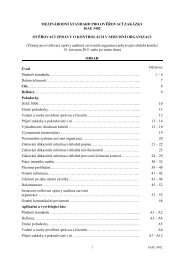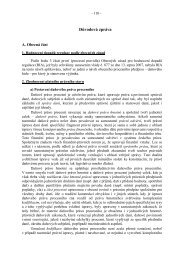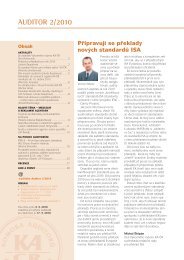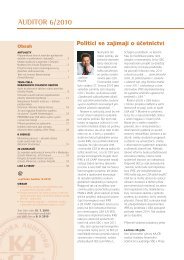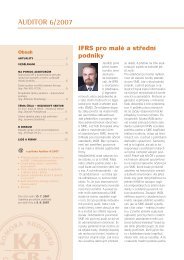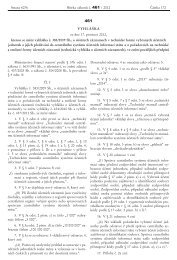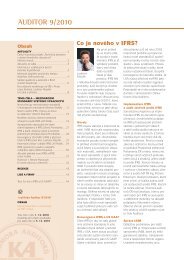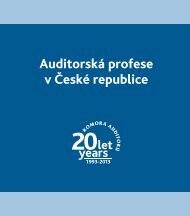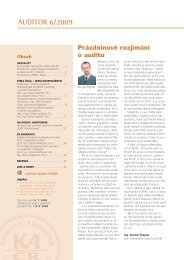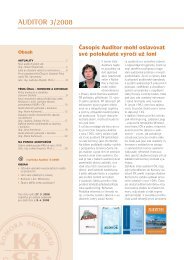Guide to Using International Standards on Auditing in - IFAC
Guide to Using International Standards on Auditing in - IFAC
Guide to Using International Standards on Auditing in - IFAC
Create successful ePaper yourself
Turn your PDF publications into a flip-book with our unique Google optimized e-Paper software.
125<br />
<str<strong>on</strong>g>Guide</str<strong>on</strong>g> <str<strong>on</strong>g>to</str<strong>on</strong>g> <str<strong>on</strong>g>Us<strong>in</strong>g</str<strong>on</strong>g> <str<strong>on</strong>g>Internati<strong>on</strong>al</str<strong>on</strong>g> <str<strong>on</strong>g>Standards</str<strong>on</strong>g> <strong>on</strong> <strong>Audit<strong>in</strong>g</strong> <strong>in</strong> the Audits of Small- and Medium-Sized Entities Volume 1—Core C<strong>on</strong>cepts<br />
Exhibit 10.4-3<br />
Questi<strong>on</strong>s <str<strong>on</strong>g>to</str<strong>on</strong>g> Address<br />
Is the Data<br />
Sufficiently<br />
Reliable for<br />
Achiev<strong>in</strong>g the<br />
Audit Objective?<br />
Is the data obta<strong>in</strong>ed from sources with<strong>in</strong> the entity, or from <strong>in</strong>dependent sources<br />
outside the entity?<br />
• The reliability of audit evidence is <strong>in</strong>creased (with some excepti<strong>on</strong>s) when it is<br />
obta<strong>in</strong>ed from <strong>in</strong>dependent sources outside the entity.<br />
Is data from sources with<strong>in</strong> the entity developed by pers<strong>on</strong>s not directly resp<strong>on</strong>sible<br />
for its accuracy?<br />
• If so, c<strong>on</strong>sider further procedures <str<strong>on</strong>g>to</str<strong>on</strong>g> check accuracy.<br />
Was the data developed under a reliable system with adequate <strong>in</strong>ternal c<strong>on</strong>trol?<br />
Is broad <strong>in</strong>dustry data available for comparis<strong>on</strong> with the entity’s data?<br />
Was the data subject <str<strong>on</strong>g>to</str<strong>on</strong>g> audit test<strong>in</strong>g <strong>in</strong> the current or prior periods?<br />
Were the audi<str<strong>on</strong>g>to</str<strong>on</strong>g>r’s expectati<strong>on</strong>s regard<strong>in</strong>g recorded amounts developed from a<br />
variety of sources?<br />
To avoid unwarranted reliance <strong>on</strong> a source of data used, the audi<str<strong>on</strong>g>to</str<strong>on</strong>g>r would perform substantive tests of the<br />
underly<strong>in</strong>g data <str<strong>on</strong>g>to</str<strong>on</strong>g> determ<strong>in</strong>e whether it is sufficiently reliable, or test whether <strong>in</strong>ternal c<strong>on</strong>trols over the<br />
data’s completeness, existence, and accuracy are operat<strong>in</strong>g effectively.<br />
In some cases, n<strong>on</strong>-f<strong>in</strong>ancial data (for example, quantities and types of items produced) will be used <strong>in</strong><br />
perform<strong>in</strong>g analytical procedures. Accord<strong>in</strong>gly, the audi<str<strong>on</strong>g>to</str<strong>on</strong>g>r needs an appropriate basis for determ<strong>in</strong><strong>in</strong>g<br />
whether the n<strong>on</strong>-f<strong>in</strong>ancial data is sufficiently reliable for the purposes of perform<strong>in</strong>g the analytical<br />
procedures.<br />
Differences from Expectati<strong>on</strong>s<br />
When differences are identified between recorded amounts and the audi<str<strong>on</strong>g>to</str<strong>on</strong>g>r’s expectati<strong>on</strong>s, the audi<str<strong>on</strong>g>to</str<strong>on</strong>g>r<br />
would c<strong>on</strong>sider the level of assurance that the procedures are <strong>in</strong>tended <str<strong>on</strong>g>to</str<strong>on</strong>g> provide and the audi<str<strong>on</strong>g>to</str<strong>on</strong>g>r’s<br />
performance materiality. The amount of the acceptable difference without <strong>in</strong>vestigati<strong>on</strong> would, <strong>in</strong> any event,<br />
need <str<strong>on</strong>g>to</str<strong>on</strong>g> be less than performance materiality.<br />
Procedures used for the <strong>in</strong>vestigati<strong>on</strong> could <strong>in</strong>clude:<br />
• Rec<strong>on</strong>sider<strong>in</strong>g the methods and fac<str<strong>on</strong>g>to</str<strong>on</strong>g>rs used <strong>in</strong> form<strong>in</strong>g the expectati<strong>on</strong>;<br />
• Mak<strong>in</strong>g <strong>in</strong>quiries of management regard<strong>in</strong>g the causes of differences from the audi<str<strong>on</strong>g>to</str<strong>on</strong>g>r’s expectati<strong>on</strong>s<br />
and assess<strong>in</strong>g management’s resp<strong>on</strong>ses, tak<strong>in</strong>g <strong>in</strong><str<strong>on</strong>g>to</str<strong>on</strong>g> account the audi<str<strong>on</strong>g>to</str<strong>on</strong>g>r’s understand<strong>in</strong>g of the<br />
bus<strong>in</strong>ess obta<strong>in</strong>ed dur<strong>in</strong>g the course of the audit; and<br />
• Perform<strong>in</strong>g other audit procedures <str<strong>on</strong>g>to</str<strong>on</strong>g> corroborate management’s explanati<strong>on</strong>s.<br />
As a result of this <strong>in</strong>vestigati<strong>on</strong>, the audi<str<strong>on</strong>g>to</str<strong>on</strong>g>r may c<strong>on</strong>clude that:<br />
• Differences between the audi<str<strong>on</strong>g>to</str<strong>on</strong>g>r’s expectati<strong>on</strong>s and recorded amounts do not represent misstatements; or<br />
• Differences may represent misstatements, and further audit procedures need <str<strong>on</strong>g>to</str<strong>on</strong>g> be performed <str<strong>on</strong>g>to</str<strong>on</strong>g> obta<strong>in</strong><br />
sufficient appropriate audit evidence as <str<strong>on</strong>g>to</str<strong>on</strong>g> whether a material misstatement does or does not exist.




